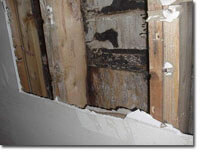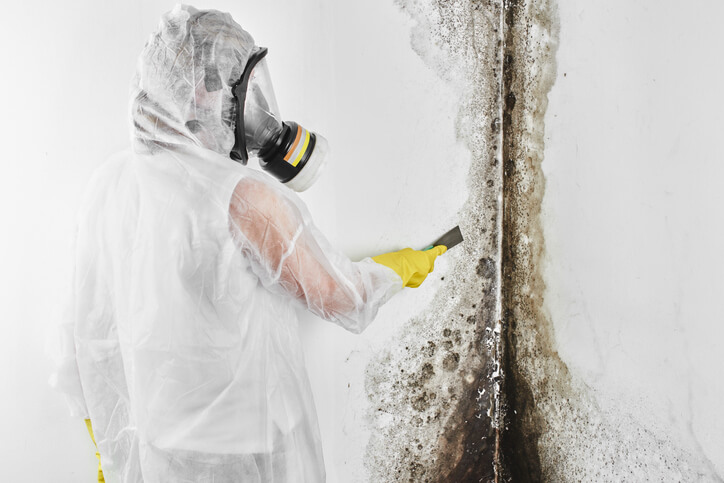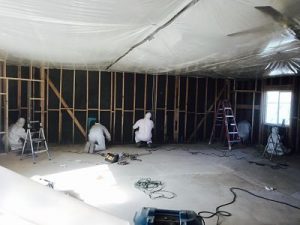Mold Info
What is Mold?
Molds are fungi. Molds grow throughout the natural and built environment. Tiny particles of mold are present in indoor and outdoor air. In nature, molds help break down dead materials and can be found growing on soil, foods, plant matter, and other items. Molds produce microscopic cells called “spores” which are very tiny and spread easily through the air. Live spores act like seeds, forming new mold growths (colonies) when they find the right conditions.
What does mold need to grow?
Mold only needs a few simple things to grow and multiply:
Moisture
Nutrients
Suitable place to grow
Should I be concerned about mold in my home?
Mold should not be permitted to grow and multiply indoors. When this happens, health problems can occur and building materials, goods and furnishings may be damaged
Can mold make me and my family sick?
Mold can affect the health of people who are exposed to it. People are mainly exposed to mold by breathing spores or other tiny fragments. People can also be exposed through skin contact with mold contaminants (for example, by touching moldy surfaces) and by swallowing it.
What symptoms might I see?
The most common health problems caused by indoor mold are allergy symptoms. Although other and more serious problems can occur, people exposed to mold commonly report problems such as:
Nasal and sinus congestion
Cough
Wheeze/breathing difficulties
Sore throat
Skin and eye irritation
Upper respiratory infections (including sinus)

EXPERT MOLD INSPECTIONS & REMEDIATION SERVICES
now enjoy having air-tight homes that improve energy efficiency, this type of home construction has reduced drafts and makes it so that homes don’t dry out as quickly as they might have in the past. This, coupled with a lack of good ventilation – while it saves on energy costs – makes homes more susceptible to mold problems.
Why Be Concerned with Mold in Your Home
Mold can cause a variety of health problems including typical allergy-like symptoms, infections, asthma, skin irritations, and chronic respiratory illnesses.
Cleaning to do testing in your home if your property has recently encountered:
Flooding
Plumbing Problems (e.g. leaky faucets, burst water pipes)
Roof Leaks
Damp Basements
Damp Crawl Spaces
Overflow from sinks, bathtubs, and/or toilets
Sewage Back-up
High Humidity (such as from summer weather, leaving a window open during the rain, steam from showers and cooking)
These are some prime causes of mold growth in Lorain homes. If any of these issues apply to your home, you and your family may be at risk. Be safe, and schedule a mold assessment from a certified Lorain mold inspection company such
So while you should be aware that normal everyday activities such as bathing without proper ventilation can cause mold growth if left unchecked, there are contributors that are outside of your control or awareness that may be producing a lot of moisture in or around your home

Mold Illness: What It Is, Common Misconceptions, and Prevention
Awareness of toxic mold’s effect on human health has increased dramatically over the past few years. But mold is only one of the many biotoxins found in water-damaged buildings, and the illness caused by exposure to these toxins is much more complex than most clinicians and patients assume.
Over the last several years, I’ve written extensively about the importance of nutrition, physical activity, stress management, sleep, social connection, pleasure, and spending time outdoors.
What Is Mold Illness?
First, I’d like to explain more about what this condition is. What we often refer to as “mold illness” or “mold toxicity” is actually a comprehensive and multifaceted syndrome known as chronic inflammatory response syndrome, or CIRS.
Mold in the Human Body
Nearly everyone becomes ill when exposed to sufficient levels of biotoxins, but most people recover once they are removed from exposure. Their detoxification system is able to recognize the biotoxins in their bodies as toxins and eliminate them via the normal mechanisms.
Patients with CIRS present with a wide range of symptoms, including:
Fatigue and weakness
Post-exertional malaise
Memory problems, difficulties with concentration, and problems with executive function
Disorientation and confusion
Headaches
Vertigo and lightheadedness
Muscle aches, cramping, and joint pains without inflammatory arthritis
Hypersensitivity to bright light, blurred vision, burning or red eyes, and tearing
Cough, asthma-like illness, shortness of breath, and chronic sinus congestion
Air hunger or unusual shortness of breath at rest
Chronic abdominal problems including nausea, cramping, and secretory diarrhea
A propensity to experience static shocks

Mold Testing
Mold can exacerbate or cause several health issues, especially in those susceptible to respiratory illness. It can also cause damage to your home or business. You may be tempted to try to get rid of the mold yourself, but because thousands of types of mold can grow in your home, do-it-yourself kits may not work.
The Environmental Protection Agency (EPA) also recommends that you hire a mold professional to test for mold, then perform mold remediation to get rid of it. Some mold, such as Stachybotrys doesn’t usually spread with airborne sporulation and may not be detected by do-it-yourself kits
What Does a Mold Test Tell Me?
When a professional mold testing company comes into your home or business, it will test for several things. Proper mold testing determines the different types of mold, how much mold is in your home or business, and where the mold is located — including in HVAC vents. Testing also tells the mold testing company if a dark substance is soot or dirt, but not mold.
Are Home Mold Testing Kits Useful?
We often get asked about the home testing kits that some of the big box stores sell for homeowners to test for mold in their home. Are they useful? In a work – no. These tests lack the basic elements of a quality test: metrics. Proper mold testing should be conducting with protocols and condition reports that allow a lab to fully account for how, when, and where a sample is taken
Setting a petri dish like container in a room, with food for mold, will more than likely show some mold growth if left long enough. What it does not do is tell the homeowner if there is an active mold growth issue in the home, what types of molds are present (giving insight regarding potential health concerns when shared with your doctor), or at what levels they are present. The old adage of “You get what you pay for” definitely rings true when testing for mold. We suggest steering clear on these do-it-youself test kits.

Mold Removal
Of all threats to your home, business, and health, mold is by far the sneakiest. The air can transfer hundreds of thousands of spores to the damp crevices of your property. Because mold thrives in darkness, a colony can thrive and spread before you even realize it’s there.
from the places it hides, to the damage it can cause, to the methods necessary to vanquish your mold infestation for good. Mold moves quickly, so our mold remediation technicians do, too. They even offer a free visual inspection for property owners, examining every inch of your property before you commit to spending a dime.
Best of all, every technician on staff has undergone comprehensive training and is IICRC certified. You have true peace of mind, knowing you can count on this expert mold removal team to find and eradicate every last trace, leaving your property better than new.
Battling And Preventing Airborne Mold
If your property has experienced any kind of water damage—even something as seemingly minor as a leaky pipe—you are at a high risk for mold contamination.
Mold spores are constantly in the air around you, looking for a dark, damp place to land. Have you had any recent water damage in your ceiling? Any moisture in your walls or crawl space? What about the drip under the kitchen sink?